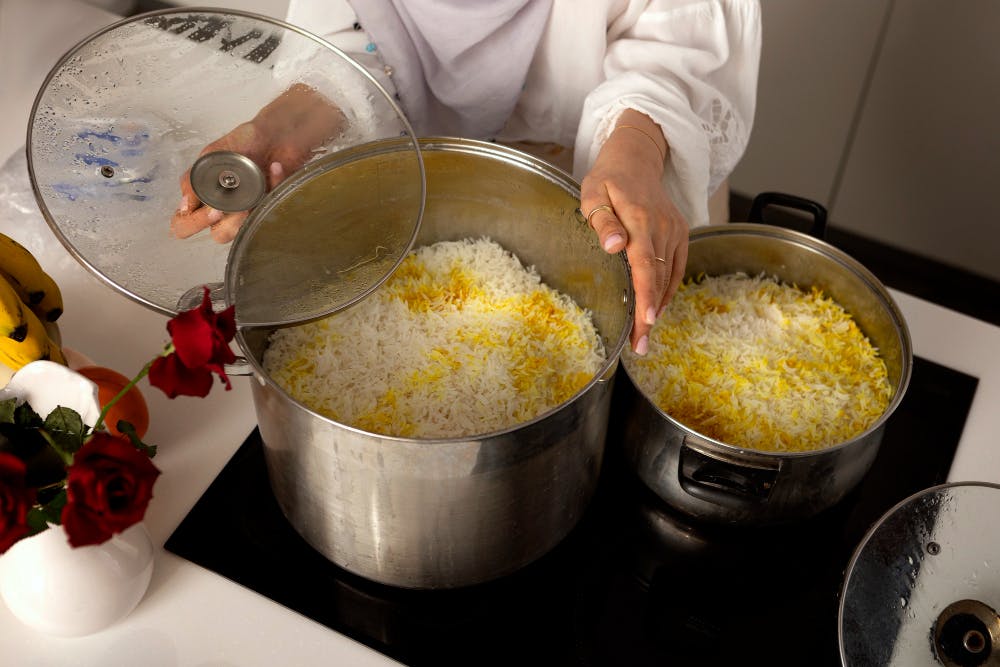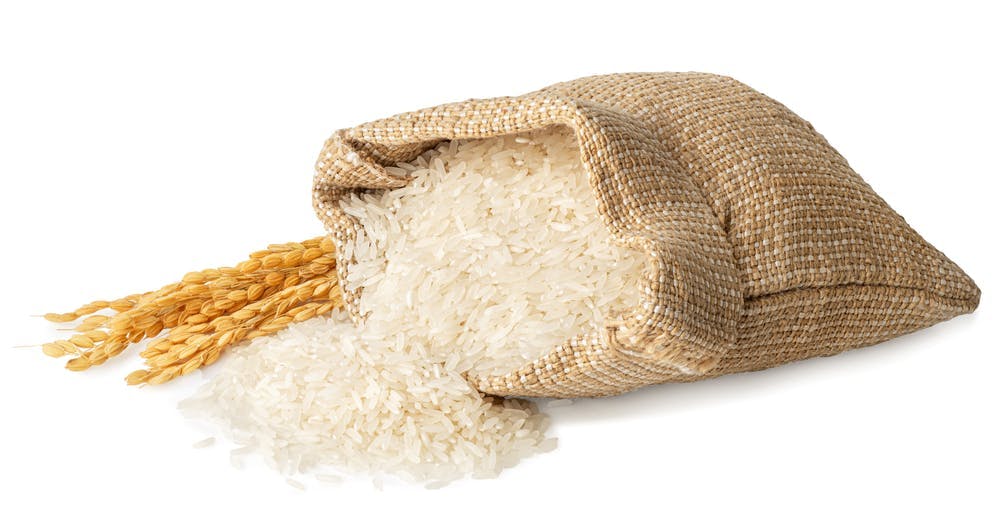Basmati Rice and Weight Loss: Can It Help You Shed Pounds?
By Karyn O.
Reviewed by Dr. Daniel Uba, MD
Published Apr 2, 2025
Updated Apr 17, 2025
15 min read

When it comes to weight loss, every food choice matters—especially carbohydrates like rice, which are often scrutinized in diet plans. Basmati rice, a fragrant, long-grain variety, is frequently praised as a healthier alternative to regular white rice. But does it truly support weight loss, or is it just another refined grain that can hinder progress?
In this comprehensive guide, Meto dives deep into the science behind Basmati rice and its role in weight management. We’ll explore its nutritional benefits, glycemic impact, how it compares to other rice varieties, and practical ways to include it in a balanced diet for sustainable weight loss.
What Is Basmati Rice?
Basmati rice is a premium long-grain rice known for its distinctive nutty aroma, delicate flavor, and fluffy texture when cooked. Originating from the foothills of the Himalayas in India and Pakistan, it has been a staple in South Asian cuisine for centuries.
It is crucial to differentiate between whole grains and refined grains like white rice. Whole grains, including brown rice, contain the entire grain kernel – the bran, germ, and endosperm. The bran and germ are packed with fiber, vitamins, and minerals, while the endosperm provides carbohydrates for energy.
White rice, on the other hand, undergoes milling, a process that removes the bran and germ, leaving behind the starchy endosperm.
Unlike regular white rice, Basmati undergoes a unique aging process that enhances its taste and texture. It comes in two primary forms:
- White Basmati Rice (polished, with the bran removed)
- Brown Basmati Rice (whole grain, retaining its fiber-rich bran and germ)
Due to its lower glycemic index (GI) and better nutrient retention compared to standard white rice, Basmati is often recommended for those managing diabetes, metabolic health, or weight loss goals. Fiber plays a vital role in weight management. It promotes satiety, keeping you feeling fuller for longer, and helps regulate blood sugar levels, preventing energy crashes and cravings.
Nutritional Profile of Basmati Rice
Understanding the nutritional breakdown of Basmati rice is crucial to determining its role in a weight loss diet.
Here’s a comparison of cooked white Basmati rice vs. brown Basmati rice per 100g serving:
Key Takeaways:
- Brown Basmati rice is richer in fiber, aiding digestion and satiety.
- White Basmati rice has fewer calories than regular white rice and a lower GI.
- Both varieties provide a moderate amount of plant-based protein.
Fiber is particularly important for weight management, so brown basmati rice offers a slight advantage.
However, it's important to note that both varieties are naturally low in fat and cholesterol, making them suitable for weight-conscious diets.
How Basmati Rice May Support Weight Loss
1. Lower Glycemic Index (GI) for Steady Energy
The Glycemic Index (GI) measures how quickly a food raises blood sugar levels. Foods with a high GI (like regular white rice) cause rapid spikes, leading to energy crashes and increased hunger.
Basmati rice has a GI of 50-58, classifying it as a medium-GI food—much better than regular white rice (GI 73+). This slower digestion helps:
- Control cravings by preventing blood sugar crashes.
- Reduce fat storage linked to insulin spikes.
- Promote sustained energy, making it easier to stay active.
2. Moderate Calorie Content for Portion Control
Weight loss fundamentally relies on a calorie deficit—consuming fewer calories than you burn. Basmati rice is relatively low in calories compared to other rice varieties, allowing for better portion management.
For example:
- 1 cup of cooked white Basmati rice: ~200 calories
- 1 cup of cooked jasmine rice: ~238 calories
- 1 cup of cooked sticky rice: ~260 calories
By choosing Basmati, you can enjoy satisfying portions without excessive calorie intake.
3. High Amylose Content for Better Digestion
Basmati rice contains a higher proportion of amylose, a type of resistant starch that digests slowly. This means:
- Longer-lasting fullness (reducing unnecessary snacking).
- Improved gut health due to slower fermentation in the intestines.
- Better metabolic response compared to sticky, high-amylopectin rices.
4. Versatility in Balanced Meals
One of the biggest advantages of Basmati rice is its ability to complement high-protein, high-fiber meals. Pairing it with lean proteins (chicken, fish, tofu) and vegetables creates a balanced plate that supports fat loss while keeping you satisfied.
Basmati Rice vs. Other Rice Varieties for Weight Loss
Not all rice is created equal. Here’s how Basmati stacks up against other popular types:
Verdict: Brown Basmati rice is the best choice for weight loss due to its fiber content and low GI, but even white Basmati is a smarter pick than regular white or jasmine rice.
How to Include Basmati Rice in a Weight Loss Diet
To maximize its benefits without overeating, follow these tips:
1. Watch Your Portions
- Stick to ½ to 1 cup (cooked) per meal.
- Use a smaller plate to avoid over-serving.
2. Pair with Protein & Fiber
- Combine with grilled chicken, fish, lentils, or tofu.
- Add non-starchy veggies (broccoli, spinach, bell peppers) to increase volume without excess calories.
3. Choose Brown Basmati When Possible
- The extra 1.8g of fiber per 100g helps with satiety and digestion.
4. Avoid High-Calorie Cooking Methods
- Steam or boil instead of frying.
- Skip heavy sauces—opt for herbs, spices, or lemon for flavor.
5. Time Your Consumption Wisely
- Eating Basmati rice post-workout can help replenish glycogen stores without fat storage.
- Avoid large portions at late-night meals when activity levels are low.
Cooking Methods and Their Impact on Basmati Rice

The delicate texture and fragrant aroma of basmati rice are not solely dependent on the variety you choose. The cooking method you employ significantly impacts the final product. Here, we explore various methods and their influence on the health benefits and overall quality of your basmati rice:
1. The Absorption Method (Stovetop):
This is the most common method for cooking basmati rice, resulting in separate, fluffy grains. Here's a breakdown of its impact:
Health Benefits:
- Rinsing: Washing the rice before cooking removes excess starch, potentially lowering the glycemic index (GI) slightly.
- Water Ratio: Using the proper water-to-rice ratio (typically 1.5:1 for white basmati rice and 2:1 for brown basmati rice) ensures even cooking and prevents mushiness. This can help maintain the fiber content, which aids in digestion and satiety.
Flavor and Texture:
- Toasting: Optionally, toasting the rinsed rice in a little oil or ghee before adding water can enhance its nutty flavor and slightly elevate the texture.
- Low Heat is Key: Cooking the rice on low heat with the lid on allows for even steam distribution and prevents scorching. This helps retain the delicate texture of the basmati rice.
2. The Pilaf Method (Stovetop):
This method involves sautéing the rice in oil or fat with aromatics like onions or spices before adding water and simmering. Here's how it affects the rice:
Health Benefits:
- Fat Addition: While adding a small amount of healthy fat like olive oil is generally acceptable, excessive oil can increase the calorie content of the rice.
- Nutrient Retention: Sautéing can introduce some browning to the rice, potentially reducing some heat-sensitive nutrients like B vitamins.
Flavor and Texture:
- Richer Flavor: Sautéing with aromatics infuses the rice with deeper flavors, creating a more complex and savory dish.
- Slight Texture Change: The pilaf method can result in a slightly firmer texture compared to the absorption method.
3. The Steaming Method:
This method uses steam to cook the rice, resulting in a light and fluffy texture. Here's its impact on the rice:
Health Benefits:
- Minimal Fat: Steaming uses minimal to no added fat, making it a healthy cooking option for weight management and those watching their fat intake.
- Nutrient Retention: Steaming is a gentle cooking method that helps preserve heat-sensitive nutrients like B vitamins found in brown basmati rice.
Flavor and Texture:
- Subtle Flavor: Steaming primarily highlights the natural flavor of the rice itself.
- Light and Fluffy Texture: Steaming results in the lightest and fluffiest basmati rice texture.
4. The Pressure Cooker Method:
Pressure cookers offer a fast and efficient way to cook basmati rice. Here's a breakdown of its effects:
Health Benefits:
- Nutrient Retention: Similar to steaming, pressure cooking helps retain heat-sensitive nutrients.
- Reduced Cooking Time: This method requires less water, which can help minimize potential nutrient loss during the cooking process.
Flavor and Texture:
- Subtle Flavor: Pressure cooking primarily highlights the natural flavor of the rice.
- Slightly Different Texture: Pressure-cooked rice can sometimes have a slightly denser texture compared to stovetop methods. Experiment with water ratios and cooking times to achieve your desired texture.
Choosing the Right Method:
The best cooking method for basmati rice depends on your preferences and priorities. Here's a quick guide:
- For Health Focus: Opt for the absorption method with rinsing, minimal oil, and low heat to maximize nutrient retention. Steaming is another excellent choice for a healthy cooking option.
- For Flavor and Aroma: Choose the pilaf method for a richer and more complex flavor profile.
- For Light and Fluffy Texture: Steaming is the best option for achieving the lightest and fluffiest basmati rice.
- For Speed and Convenience: The pressure cooker offers the fastest cooking time, ideal for busy weeknights.
No matter which method you choose, remember to use the proper water-to-rice ratio for your chosen variety of basmati rice (white or brown) to ensure even cooking and prevent mushiness.
Incorporating Basmati Rice into a Weight-Loss-Friendly Diet

Basmati rice, with its delicate flavor and versatility, can be a valuable tool in your weight-loss journey. Here, we delve deeper into how to incorporate basmati rice into your meals while keeping your calorie intake and portion sizes in check:
Building Balanced Plates:
- Portion Control is Paramount: This may seem obvious, but it's crucial. Stick to a ½ cup to 1 cup serving of cooked basmati rice per meal. Measure your rice using a measuring cup to ensure you're not overindulging.
- Focus on Lean Protein: Pair your basmati rice with lean protein sources like grilled chicken, fish, tofu, or lentils. Aim for a serving size of around 3-4 ounces of protein per meal. This will help you feel satiated and prevent overeating.
- Embrace Vegetables: Vegetables are your friends on a weight-loss journey. They are low in calories and high in fiber, vitamins, and minerals. Fill half your plate with a variety of colorful non-starchy vegetables like broccoli, asparagus, carrots, or leafy greens.
- Spice Up Your Life: Don't be afraid to experiment with herbs and spices to add flavor to your basmati rice dishes without adding unnecessary calories. Explore options like cumin, turmeric, coriander, ginger, or a sprinkle of chili flakes for a spicy kick. Spices can also help you feel more satisfied with your meal.
- Healthy Fats: Including a small amount of healthy fats in your meals can help with satiety and nutrient absorption. Opt for a drizzle of olive oil, avocado slices, or a sprinkle of nuts or seeds.
Recipe Inspiration:
Here are some delicious and weight-conscious recipe ideas featuring basmati rice:
- Lemon Herb Chicken with Basmati Rice and Roasted Vegetables: This is a simple and flavorful one-pan meal. Marinate boneless, skinless chicken breasts in lemon juice, olive oil, herbs like rosemary and thyme, and garlic. Roast the chicken with chopped vegetables like broccoli, carrots, and bell peppers on a baking sheet. Cook brown basmati rice according to package instructions and serve it alongside the roasted chicken and vegetables.
- Spicy Shrimp Stir-fry with Basmati Rice: This is a quick and healthy option for busy weeknights. Sauté shrimp in a wok or large pan with a drizzle of sesame oil. Add chopped vegetables like onions, peppers, and sugar snap peas. Stir in a homemade stir-fry sauce made with low-sodium soy sauce, rice vinegar, ginger, garlic, and a touch of chili flakes. Serve over cooked brown basmati rice for a complete and flavorful meal.
- Mediterranean Basmati Rice Salad: This flavorful salad is perfect for a light lunch or side dish. Cook brown basmati rice and let it cool. Combine chopped cucumber, tomatoes, red onion, crumbled feta cheese, black olives, and chopped fresh herbs like parsley and mint. Drizzle with a simple vinaigrette dressing made with olive oil, lemon juice, and a touch of oregano.
- Vegetarian Buddha Bowl with Basmati Rice: Buddha bowls are a great way to create a customized and nutrient-packed meal. Start with a base of cooked brown basmati rice. Add roasted vegetables like butternut squash, chickpeas, sliced avocado, a drizzle of tahini sauce, and a sprinkle of toasted pumpkin seeds. This bowl offers a variety of textures, flavors, and essential nutrients.
Beyond the Plate:
- Mindful Snacking: If you're craving a snack between meals, consider air-popped popcorn, a handful of almonds, or some sliced vegetables with a dollop of hummus. These options will keep you feeling full without adding unnecessary calories from refined carbohydrates.
- Hydration is Key: Drinking plenty of water throughout the day is crucial for weight loss and overall health. Water helps you feel full, reduces cravings, and aids in digestion. Aim for 8-10 glasses of water per day.
- Planning and Preparation: Planning your meals and snacks for the week can help you avoid unhealthy choices when you're feeling hungry or short on time. Prepare your basmati rice in advance and store it in an airtight container in the refrigerator for quick and easy meal prep.
By incorporating these tips and recipes, you can enjoy the delicious taste and health benefits of basmati rice while staying on track with your weight-loss goals. Remember, consistency and a balanced approach are key to achieving lasting success.
Potential Downsides of Basmati Rice for Weight Loss
While Basmati rice is a healthier option, it’s not without drawbacks:
- Still a Carb-Dense Food – Overeating any rice can stall weight loss.
- White Basmati Lacks Fiber – Opt for brown when possible.
- Easy to Overconsume – Its mild flavor can lead to larger portions if not measured.
Final Verdict: Is Basmati Rice Good for Weight Loss?
Yes—Basmati rice can be part of a successful weight loss plan when consumed mindfully. Its lower GI, moderate calorie content, and versatility make it a superior choice over regular white rice.
For best results:
- Choose brown Basmati for extra fiber.
- Control portions (½ - 1 cup per meal).
- Pair with protein and veggies for balanced nutrition.
- Stay active to optimize metabolism.
At Meto, we believe in smart, sustainable eating—Basmati rice, when used strategically, can be a delicious and effective part of your weight loss journey!
Frequently Asked Questions (FAQs)
1. Is Basmati Rice Organic?
Basmati rice can be organic or non-organic. Look for the USDA Certified Organic label on the packaging to ensure it meets organic standards. Organic basmati rice may be slightly more expensive but may also be free of pesticides and other chemicals.
2. How Long Does Basmati Rice Last?
Uncooked basmati rice, both white and brown, has a long shelf life if stored properly in a cool, dry place in an airtight container. It can typically last for up to one year. Cooked basmati rice should be stored in an airtight container in the refrigerator and consumed within 3-4 days.
3. Is Basmati Rice High in Arsenic?
Arsenic is a naturally occurring element found in trace amounts in soil and water. Some studies have shown that certain types of rice, particularly from specific regions, can have slightly higher levels of arsenic. However, basmati rice, especially from India and Pakistan, is generally considered to be lower in arsenic compared to other rice varieties.
4. Is Basmati Rice a Good Source of Protein?
Basmati rice, both white and brown, is not a high-protein grain. A single serving (cooked cup) contains around 5 grams of protein. To ensure you're getting enough protein on a weight-loss diet, pair basmati rice with lean protein sources like chicken, fish, beans, or tofu.
5. Does Basmati Rice Need to Be Soaked Before Cooking?
Soaking basmati rice is not strictly necessary but can be beneficial. Soaking for 30 minutes to an hour can help remove excess starch, potentially lowering the GI slightly and improving the texture of the cooked rice.
6. Can I Reheat Basmati Rice?
Yes, you can reheat leftover basmati rice. However, it's important to do so safely to prevent bacterial growth. Reheat basmati rice only until it is steaming hot throughout and discard any leftovers that have been sitting at room temperature for more than 2 hours.
7. Is Basmati Rice Suitable for Diabetics?
Basmati rice, both white and brown, has a lower GI compared to regular white rice. This can be beneficial for diabetics who need to manage their blood sugar levels. However, it's still important to practice portion control and monitor blood sugar levels when consuming any carbohydrate source.
8. Is Basmati Rice a Good Source of Carbs?
Yes, basmati rice is a good source of carbohydrates, with around 46 grams per cooked cup. However, the type of carbohydrate matters. Brown basmati rice contains more complex carbohydrates and fiber compared to white basmati rice, which can help with blood sugar management and satiety.
Share this article

Low Sodium Diet: Simple Guidelines, Food Lists, and Tips for Better Health
Lilian E.
Sep 30, 202512 min read

Does Coconut Milk Affect Blood Sugar Levels? A Complete Guide for Diabetes and Healthy Living
Karyn O.
Sep 29, 202510 min read

5 Best Bone Broths for Health, Nutrition, and Gut Support (Nutritionist-Backed Guide)
Karyn O.
Sep 24, 202511 min read

Best-in-class care is a click away
Find everything and everyone you need to reach your metabolic health goals, in one place. It all makes sense with Meto.
Join Meto